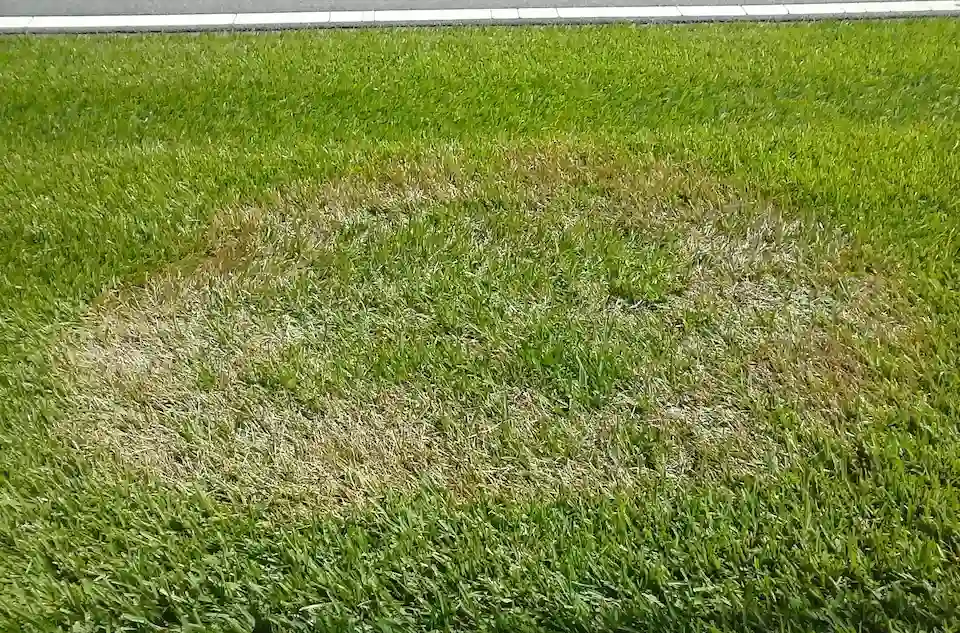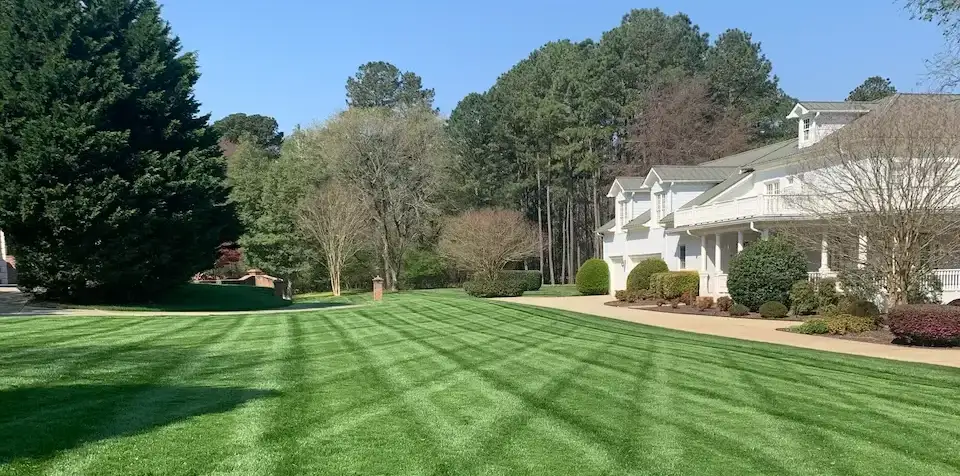Tall Fescue Diseases: Understanding Brown Patch and Strategies to Minimize Severity
When you look at your lawn, do you notice brown patches that look burned out? If so, your lawn probably has developed brown patch disease. It’s a very common condition that impacts cool-season grasses, like tall fescue.
Once you notice the problem, it’s time to attack it so you can improve the health of your lawn now and prevent further damage. At Turf TitanZ, our lawn fertilization team takes your lawn’s condition very seriously and wants you to be informed about conditions that can impact its appearance. That’s why we’re providing this useful information when it comes to tall fescue fungal diseases. We’re going to take a look at everything from common symptoms to preventative measures and let you know how Turf TitanZ can help keep your lawn in the best shape possible.

Common Fungal Diseases Affecting Tall Fescue & Other Cool-Season Grasses
As a cool-season grass, tall fescue grass is most prone to brown patch development, but can be susceptible to several common diseases:
Brown Patch Disease
Brown Patch is a fungal disease of cool-season turfgrasses. It is most severe during very hot and humid weather. Poor drainage and air circulation can all lead to brown patch disease. Also, overwatering the grass and watering it late in the afternoon can lead to problems.
Dollar Spot
If your tall fescue has Dollar Spot, you’ll notice the affected leaves look like white or tan lesions. The grass in the spots may die if the disease progresses.
Fairy Ring
Don’t let the name fool you. Nothing is appealing about Fairy Ring when talking about your lawn. Fairy Ring presents itself in patches or rings that are about 1 foot or less in diameter. But they can quickly grow if not taken care of.
Symptoms of Brown Patch Development
Visual Signs of Disease Development on Tall Fescue Lawns
If your tall fescue lawn has brown patch disease, you’ll know it pretty quickly. You’ll start to see brown or yellow circular patches that are about 6 inches to several feet in diameter. The affected leaves will have tan lesions, an irregular shape, and a dark brown border.
Identification of Brown Patch in Different Growth Stages
Mowing height will affect what the brown patches on your lawn look like. If your lawn is mowed higher than one inch tall, you’ll notice brown patches as roughly circular patches that are brown or yellow. In close-cut grass of one inch or less, the patches will be circular but will be brown or orange. You’ll also notice a black or dark gray ring form around the patches as well.
Causes and Contributing Factors
Environmental Conditions
Brown patch is the worst during extended periods of hot and humid weather. It is most severe when the low and high temperatures are about 70 and 90 degrees respectively. When the grass leaves are continuously wet for at least 10 to 12 hours, the brown patches can start to appear.
Maintenance Practices
The way you mow your lawn can also lead to brown patch disease. Dull blades will shred and damage your lawn. Sharpen your blades and readjust the lawn mower to the correct height to avoid this problem. If your lawn mower is leaking, you can also cause a chemical burn and brown patches. You can fix this issue by making sure you never overfill the fuel tank and by not refilling the tank on your lawn.
Soil Conditions
Poor soil quality, such as compacted or nutrient soil can affect the root system and make your lawn more prone to disease. The pH levels may also be off and not good for your grass.
Understanding Brown Patch Severity
Factors That Increase Brown Patch Severity
Several factors can impact the severity of the brown patches that are invading your lawn. These include:
- Using fertilizer with excessive nitrogen
- Overwatering in late afternoon or evening
- Poor soil drainage
- Shade and poor air circulation
- High mowing height
- Excessive thatch
- Mowing when wet
Long-term Consequences for the Health of Tall Fescue
In most cases, tall fescue lawn grasses that have been impacted by brown patch disease can recover. But, if your grass is less than one year old, it may die as a result. This is one of the many reasons why you’ll want to call the pros at Turf TitanZ to take care of your lawn at the first signs of disease development.
Strategies to Minimize Brown Patch Severity
Proper Mowing Techniques and Height
While you don’t want your lawn to be too short, you also don’t want it to grow too high that the sun is penetrating the surface and moving heat and moisture away. Keep your mower higher about 1/2 inch than normal during the summer to prevent this problem. Water your lawn either early in the morning or between 4 p.m. to 6 p.m. to ensure that the grass dries out before nightfall. If your grass is wet all night, it can become more prone to disease and pests.
Irrigation and Watering Strategies
Set your irrigation system so that your grass gets watered early in the day. This will minimize leaf wetness at night. If you notice your lawn has morning dew, there’s a good chance you don’t have to mow your lawn at all. You may want to invest in rain sensors and smart controllers to make sure that you are not overwatering your grass.
Aeration and Dethatching
Aeration can improve the drainage and air circulation of the grass root system and reduce the damage brown patch disease can cause. Talk to the team at Turf TitanZ about having your lawn aerated if you’re concerned about brown patch disease.
Dethatching is another technique to look into. Dethatching removes excess thatch from your lawn so that air, nutrients, and water can effectively reach the soil. It can be done with a rake or with power equipment to make the process go quicker.
Fungicide Treatments
Fungicides can help to control brown patches. You can use them as a preventative measure in late spring or early summer or for brown patch control when you start to notice problems.

Prevention and Long-Term Management
Soil Testing and Nutrient Management
Get your soil tested and apply fertilizer depending on the results. Brown patch disease may be more severe if the soil pH is less than 6.0. You’ll also want to keep the soil potassium and calcium levels at the upper end of what is deemed sufficient by soil tests.
Choosing Resistant Tall Fescue Varieties
Choosing disease-resistant tall fescue varieties can also help to prevent brown patch disease and other turfgrass diseases. Your lawn care specialist can recommend the best type for your lawn.
Prevent and Treat Tall Fescue Diseases With The Help Of Turf TitanZ
You can trust Turf TitanZ for all of your lawn maintenance needs as well as preventing and treating tall fescue diseases. Our team of lawn care professionals will recommend the best course of treatment so that you are left with a plush, green lawn. Call us today at (919) 562-0771 or contact us via the form below to learn more about how we can treat and maintain your lawn.
